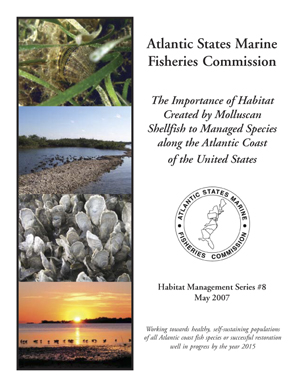|
Funding Opportunities
|
|
|
Distributed by The Nature Conservancy's Global Marine Initiative
|
ASMFC Publishes
Shellfish Habitat Synthesis
The Atlantic States Marine Fisheries Commission (ASMFC) is responsible for developing and promoting effective fisheries management strategies among the 15 coastal U.S. states from Maine to Florida, including Pennsylvania. Management plans have been developed and are being implemented through ASMFC for 22 species of fish and shellfish that are shared among some or all of the states in the Commission’s geographic range. Habitat management and protection is an important component of management plans, but quite often information about various habitats of importance to fishery managers is dispersed within the peer-reviewed and gray literature. To address this challenge for bivalve mollusc dominated habitats, ASFMC commissioned a report on the value of shellfish habitat to the array of species managed through ASMFC. The report summarizes recent and historic studies to characterize the four most important characteristics of shellfish habitat – “hard substrate, vertical structure, food, and water quality regulation” – that benefit the species managed through ASMFC. The report also notes the challenges that remain for effectively managing shellfish in a habitat context. Significant data gaps exist regarding (among other topics) distribution, bivalve health and physiology in response to climate change and harmful algal blooms, community ecology, restoration techniques and shellfish responses to environmental change. This publication should be of great value to the restoration community as a general resource and platform for developing multi-species management approaches. Coen, L.D. and R.E.Grizzle. 2007. The importance of habitat created by molluscan shellfish to managed species along the Atlantic coast of the United States. ASMFC Habitat Management Series #8. Washington DC. 107pp. http://www.asmfc.org/ (available through ‘Publications’ and ‘Habitat Documents’)
|
|
Status Review published for the Eastern
Oyster
The Status report concludes that, although not threatened with extinction, the species does face a variety of threats throughout its range, including habitat loss from development and historic over-fishing, water quality degradation/harmful algal blooms, and natural environmental disasters such as hurricanes. These and other threats vary in their intensity from place to place, but none were considered overarching or critical to long-term species survival standpoint. However, the report also notes that restoration is being conducted throughout the species’ range and is perceived to be an important strategy for ensuring optimal fisheries productivity and, in some locations, recovery from steep declines (e.g., mid-Atlantic estuaries and northward). Citation: Eastern Oyster Biological Review Team. 2007. Status review of the eastern oyster (Crassostrea virginica). Report to the National Marine Fisheries Service, Northeast Regional Office. February 16, 2007. 105pp. The full Status Review report, as well as the original Petition and Findings are available on NOAA’s website.
NOAA launches new Restoration
Portal
Estuarine
Research Federation 2007 Conference, November 4-8
Estuaries Restoration Act – proposals due August 20, 2007 NOAA
Community-based Restoration Program – proposals due September 27,
2007 | |||
|
|
 | ||





